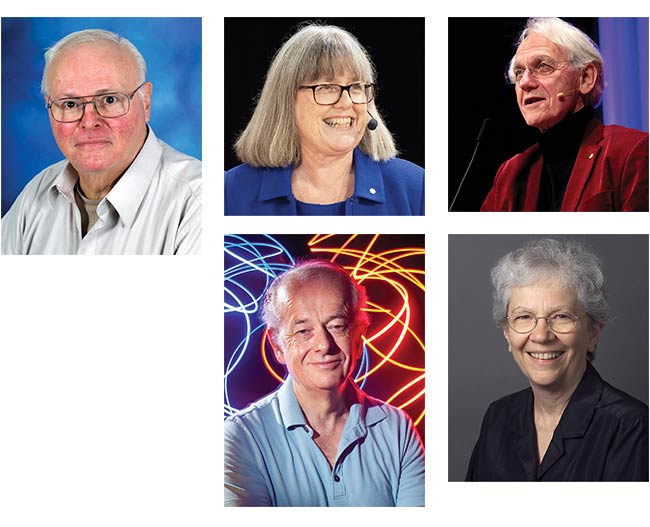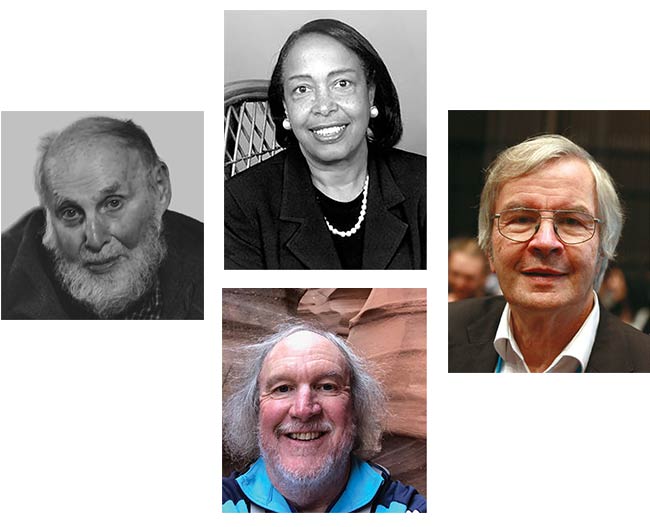Listed here are many breakthroughs that followed the first ruby laser demonstration. Nearly all of the devices mentioned have played major roles in science or everyday life, and continue to today. This brief list of pioneers — not exhaustive by any means — places a human face on scientific progress and helps, like the technology itself, to inspire the international imagination.

Robert Alfano (top left) Donna Strickland (top middle, courtesy Bengt Nyman) Gérard Mourou (top right, courtesy Joseph Xu, Michigan Engineering) Federico Capasso (bottom middle, courtesy Eliza Grinnel, Harvard SEAS) Mary Louise Spaeth
(bottom right, courtesy Lawrence Livermore National Labs)
Narinder Kapany
“Father of fiber optics”; coined the term fiber optics in Scientific American, 1960.
Leo Johnson, Kurt Nassau, G.D. Boyd, and R.R. Soden, Bell Labs
Demonstrated first continuous-wave laser that operated at room temperature — a 1.06-µm device made with Nd-doped calcium tungstate (CaWO4), 1961.
Elias Snitzer, American Optical
Invented and demonstrated the first fiber laser, 1963.
Developed and demonstrated the first double-clad fiber laser, along with his team at Polaroid, 1988.
Peter Franken, A.E. Hill, C.W. Peters, and G. Weinrich, University of Michigan
Discovered second-harmonic generation, 1961.
Alan D. White and J. Dane Rigden, Bell Labs
Developed first HeNe laser at visible wavelength (632.8 nm), 1962.
Robert W. Hellwarth and R.J. McClung, Hughes Labs
First demonstration of Q-switching, 1962.
Robert N. Hall, GE Research and Development Laboratories
First semiconductor (GaAs) diode laser, 1962.
Marshall I. Nathan, IBM Watson Research Center
Second semiconductor laser, 1962.
C. Kumar N. Patel, Bell Labs
First high-power gas laser (CO2), 1964.
J.E. Geusic, H.M. Marcos, and L.G. Van Uitert, Bell Labs
First Nd:YAG laser, 1964.
Earl Bell and Arnold Bloom, Spectra-Physics Inc.
First pulsed ion laser (Hg+), 1964.
William Bridges, Hughes Aircraft
Invented pulsed argon-ion laser, 1964.
George C. Pimentel, UC Berkeley
With J.V.V. Kasper, developed first chemical laser (3.7 µm, HCl), 1965.
Mary Louise Spaeth, Hughes Aircraft
Invented first tunable dye laser, enabling a single laser to emit different wavelengths of light for the first time, 1966.
Peter Sorokin, IBM
Developed, with Mirek Stevenson, first uranium-doped and samarium-doped lasers, 1960.
First pulsed, fixed-wavelength dye laser, 1966.
Bernard H. Soffer and B.B. McFarland, Korad Inc.
First wavelength-tunable pulsed dye laser, 1967.
William Silfvast, Bell Labs
Pioneered work in the fields of metal vapor lasers, recombination lasers, photo-ionization-pumped lasers, and laser plasmas. First continuous-wave HeCd laser, 1967.
Theodor W. Hänsch
Contributed, along with Arthur Schawlow, to the development of laser-based spectroscopy, 1970. Invented the narrow-linewidth laser, 1972.
Shared Nobel Prize with John L. Hall for contributions to the development of laser spectroscopy, 2005.
Robert Alfano
Discovered supercontinuum from self-phase modulation, which led to advancements in ultrafast laser science and nonlinear optical imaging, 1970.
Stabilized mode-locked Nd glass laser, 1981. Emerald laser, 1984.
Five tunable NIR Cr3+ and Cr4+ lasers, 1990, 1991, 1996, 2005, and 2008.
Izuo Hayashi, Bell Labs
First room-temperature continuous-wave semiconductor laser, 1970.
Nikolai Basov, V.A. Danielychev, Yu M. Popov, and D.D. Khodkovich
First excimer laser (176 nm, Xe2), 1970.
John M.J. Madey, Stanford University
First free-electron laser, 1971.
Stuart Searles et al., Naval Research Lab
First rare-gas halide (XeBr) laser, 1975.
Kenichi Iga, Tokyo Institute of Technology
First conception of a surface-emitting laser, later named the VCSEL, which operated in contrast to conventional Fabry-Perot edge-emitting semiconductor lasers, 1977.

Arthur Ashkin (left, courtesy Bengt Nyman) Patricia Bath (top middle, courtesy National Library of Medicine) Jack Jewell (bottom middle) Theodor Hänsch (right, courtesy of Markus Posse)
Dennis Matthews, Mordy Rosen, and Rich London, Lawrence Livermore National Labs
Demonstrated first operational x-ray laser, based on Peter Hagelstein’s dissertation, 1984.
Gérard Mourou and Donna Strickland, University of Rochester
Won half of the 2018 Nobel Prize in physics for devising the technique of chirped pulse amplification, and paved the way for creating very short and very intense laser pulses, 1985.
Arthur Ashkin, Alcatel-Lucent Bell Labs
Awarded half of the 2018 Nobel Prize in physics for his demonstration of optical tweezers, which employ a highly focused laser beam to hold and move microscopic objects, 1986.
Patricia Bath, Laser Medical Center, Berlin
Developed the internationally popular technique for ablating and removing cataracts, for which she patented the Laserphaco Probe device, 1988.
Larry Coldren, UC Santa Barbara
Invented the differing multielement mirror laser, the basis of the sampled-grating distributed Bragg reflector (DBR) laser, 1988.
Proposed innovative use of VCSEL gain elements, key to all commercial VCSELs, 1988.
Foundational work with diode lasers and photonic integrated circuits, 1995-2019.
Jack Jewell, Axel Scherer, Sam McCall, Yong-Hee Lee, Jim Harbison, Leigh Florez, and Sue Walker, Bell Labs
Demonstrated over a million VCSELs on a 6- × 8-mm chip, paving the way for today’s annual production of over a billion chips, each with multiple lasers, 1989.
Ursula Keller, AT&T Bell Labs
Invented the semiconductor saturable absorber mirror (SESAM), which broke laser light into extremely short pulses and gave lasers more accurate control over materials processing, 1992.
Federico Capasso, Bell Labs
Invented and developed the quantum cascade laser, and demonstrated its many applications to spectroscopy and chemical sensing, 1994.
Margaret Murnane and Henry Kapteyn, KMLabs
Designed and demonstrated the first 10-fs Ti:sapphire laser, 1994.
Sir David N. Payne, University of Southampton
Pioneered work in fiber fabrication and influenced development of fiber lasers, 1970s.
Led teams that invented the single-mode silica fiber laser and amplifier, and broke the kilowatt barrier for the output power of a fiber laser, 2004.
Developed an erbium-doped laser, 2009.
Written by Lynn Savage (2010); Hank Hogan, Joel Williams, and Susan Petrie
NEARLY PIONEERS
Willis Lamb Jr. and R.C. Retherford came close to pursuing induced emissions, but didn’t.
Joseph Weber, at the University of Maryland, and A.M. Prokhorov and Nikolai G. Basov, at the Lebedev Physics Institute in Moscow, separately pursued construction of a maser at the same time as Charles H. Townes, but Townes got there first.
In 1954, Robert H. Dicke proposed an “optical bomb” that would use a short excitation pulse to produce a population inversion, which in turn would create an intense burst of spontaneous emission. In a 1958 patent, he suggested that parallel mirrors would form a resonant optical cavity, but he didn’t build it.
In 1907, H.J. Round saw electroluminescence when he applied an electric field to silicon carbide, which is a semiconducting material. However, the first semiconductor maser wasn’t developed until 1962.
Sources
Elias Snitzer
www.osa.org/en-us/about_osa/newsroom/obituaries/2012/elias_snitzer
Mary Louise Spaeth
https://lasers.llnl.gov/about/who-works-at-nif/management/mary-spaeth
www.washingtonpost.com/archive/1997/03/12/mothers-of-inventions/ccb52eec-5018-4aee-aec5-517c5125cb8d/?noredirect=on&utm_term=.5e2a2ac9805b
Theodor W. Hänsch
www.britannica.com/biography/Theodor-W-Hansch
https://www.journals.aps.org/files/RevModPhys.78.1297.pdf
Kenichi Iga
www.jspsusa.org/FORUM2002/bio.Iga.htm
Dennis Matthews, Mordy Rosen, and Rich London
www.llnl.gov/news/30-years-and-counting-x-ray-laser-lives
William Silfvast
http://silfvast.creol.ucf.edu
Gérard Mourou and Donna Strickland
www.rochester.edu/newscenter/rochesters-breakthrough-in-laser-science-earns-nobel-prize-340302
Arthur Ashkin
www.physicsworld.com/a/arthur-ashkin-gerard-mourou-and-donna-strickland-the-nobel-prize-for-physics
www.osa.org/en-us/about_osa/newsroom/news_releases/2009/ashkin/
Patricia Bath
www.biography.com/scientist/patricia-bath
www.invention.si.edu/innovative-lives-right-sight-patricia-bath
https://cfmedicine.nlm.nih.gov/physicians/biography_26.html
Ursula Keller
www.epo.org/learning-events/european-inventor/finalists/2018/keller.html
www.epo.org/news-issues/press/releases/archive/2018/20180607d.html
Margaret Murnane and Henry Kapteyn
www.kmlabs.com/history
Sir David N. Payne
www.photonics.com/Articles/Queen_knights_fiber_laser_pioneer/p2/v111/i675/a53317
www.osa.org/en-us/the_optical_society_blog/2016/december_2016/sir_david_payne_on_the_power_of_light
www.osapublishing.org/DirectPDFAccess/F77421CF-DFAD-9840-1C28939F18046DEA_81942/oe-12-25-6088.pdf?da=1&id=81942&seq=0&mobile=no
Valentin Gapontsev
https://en.wikipedia.org/wiki/Valentin_Gapontsev
www.laserfocusworld.com/articles/print/volume-38/issue-8/features/fiber-lasers/fiber-lasers-grow-in-power.html